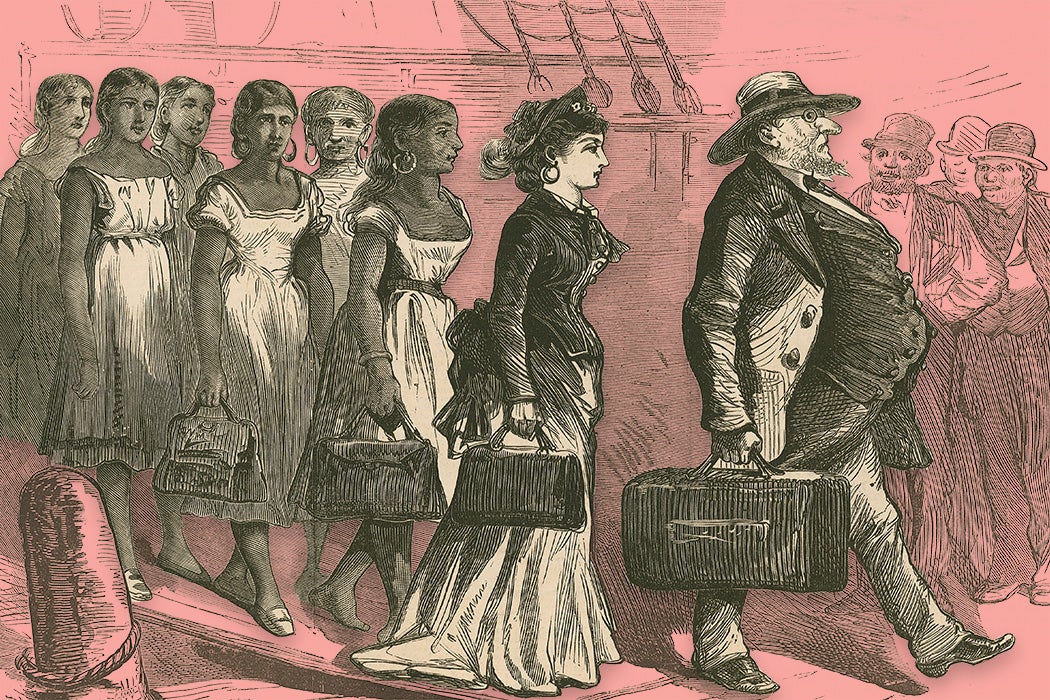In April 1830, New Yorker Joseph Smith created what would become known as the Church of Jesus Christ of Latter-day Saints (LDS), a made-in-America branch of Christianity that would become a source of faith, change, and controversy not just for its members but for many outside of the church as well. As Brent M. Rogers describes, Smith believed he was called to establish a “New Jerusalem” known as Zion and first located the faith’s headquarters in Ohio, before moving to Missouri, with the intention of establishing it there. Yet the stay in Missouri was short-lived. It was marked by attacks from locals wishing to drive Smith out and by financial scandals which fractured church membership; by 1839, the governor had expelled the Latter-day Saints.
For a while, it seemed that the adherents to this new faith had found a home in the Illinois town of Nauvoo, writes Rogers; it surged in population with the new converts, and dispatched missionaries. In Nauvoo, Smith revealed his First Vision; an angel instructed him to introduce polygamy into the LDS community. As many as 115 men and women in Nauvoo participated in the practice before Smith’s death. Smith himself married at least thirty women between 1841 and 1844, when a mob killed him, along with his brother and presumed successor, at the jail in Carthage. Their deaths left a leadership vacuum as well as a growing sense that the Latter-day Saints would have to venture farther west to escape future attacks from those who opposed or and splintered from them.
The surviving leadership elected Brigham Young, an LDS member influential in missionary efforts, to take the helm. Under Young’s leadership, the LDS set out to find a new location to grow their ranks. By 1846, they’d set sights on the Great Salt Lake Valley, then controlled by Mexico, as a refuge from the unwelcome oversight of the US government. As documented by Utah journalist and historian Harold Schindler, the settlers arrived in 1847—bad timing, as the next year control of the territory was transferred to the United States as part of the treaty that ended the Mexican-American War. The LDS were now on US soil, if not in an actual state. That meant that the LDS church was still independent of federal oversight, and believers from around the country migrated to the Salt Lake area. The territory soon became dominated by church influence in the legal, economic, political, and religious sectors, according to political scientist Orma Linford. Emboldened by this sovereignty and the appointment of Young as territorial governor in 1852, the church made public its practice of polygamy.

The motifs that have come to define the period of American history leading up to the Civil War likewise characterize the first few decades of existence of the LDS. A new idea, reviled by some and embraced by others, takes root in an established city on the East Coast. Fearing persecution or perhaps fleeing scandal, its originator seeks ever less populated areas in which to advance leadership, aiming for maximal freedom and control while also finding land which the group can conquer for a home base. As the movement grows, it ruptures, diverges, and comes into increasing conflict with the law. For the LDS church, the wedge issue was their practice of polygamy, but the focus on its salacious aspects overshadowed the fact that the legality of this belief largely served as a stage on which government officials and LDS leaders acted out the conflicts over territorial control. Polygamy, or bigamy as it was defined under the law, ran up against the image of the ideal nuclear family that existed at the time. Furthermore, the control Young and his successors exerted over the Utah Territory offered a blueprint for a type of conflict to beset the US repeatedly: that between the federal government and a band of settlers on the Western edge of the nation.
Overviews of US military history in the mid-1800s cover the Civil War; less discussed is the Utah War of 1857. Alternately known as the Utah Campaign and the Mormon War, among other names, the conflict predicted many of the same clashes that would emerge between Northern and Southern states a few years later. Historian Thomas G. Alexander writes that the newly elected President James Buchanan had featured the LDS church and its practice of polygamy as key campaign issues during his presidential run, a move largely dictated not by a personal dislike for the LDS faith, but rather as a reaction to claims that Buchanan and the Democrats were giving too much leeway to issues of both polygamy and slavery. By mid-1857, federal troops had begun to move toward Utah from Fort Leavenworth, Kansas and in April 1858, Buchanan had issued a presidential proclamation demanding the allegiance of Utah government officials to the federal government. Faced with a lack of information about the military’s aims for the Utah Territory, LDS militias began to prepare defenses in the area hoping to hamper the troops’ progress. In the period of ratcheting tensions leading up to the war, groups of non-LDS settlers were killed by these militias in incidents including the Mountain Meadows Massacre, Alexander writes, under suspicion of harboring disguised troops or perhaps being US Army spies.

According to Schindler’s research, while the outgoing President Millard Fillmore had appointed Young governor of Utah, Buchanan and his generals took a dim view of Young’s ambitions to establish what would be known as the state of Deseret to be overseen by the LDS Church. The conflict was eventually resolved in 1858, writes Schindler, after Buchanan succumbed to Congressional pressure to wrap up what was seen as a stalemate headed toward an unwinnable conflict. In exchange for a blanket pardon of LDS members involved in the fighting, Young had to accept being replaced as governor. He also had to agree to the stationing of federal troops in Utah. The federal government for its part declared it would not prevent the free practice of religion in Utah Territory. While polygamy was not explicitly mentioned in the formal statements ending the conflict, it continued to be a source of contention between the leaders of the territory and the federal authorities and would become the driving issue for further federal involvement in the region.
Contemporaneous newspaper accounts demonstrate how polygamy served as a stand-in for the right of states and territories to self-determination. In May 1862, an opinion piece entitled “A Bill to Punish Polygamy” published in a Sacramento newspaper raised questions about the feasibility of enforcing a law against the practice passed by the Congress given how far Utah was from the nation’s capital. It didn’t condemn polygamy on moral grounds but rather questioned how the federal government could practically enforce this law absent troops. The authors opined that the solution should be to admit Utah as a state and let public opinion sort out the matter. These sorts of articles set the stage for the issue of men taking multiple wives as part of the LDS belief structure to become more than a moral argument. While plenty of Americans may have looked down upon polygamy as immoral, they also had concerns about federal interference to prohibit what was, at its core, a sincerely held religious belief.
Viewed through the lens of history, it’s almost impossible to see these conflicts as anything other than a precursor to the coming Civil War. Much of the LDS defense of their actions in Utah Territory relied on the concept of popular sovereignty; LDS leaders argued that since the population governing the area around the Salt Lake Valley was overwhelmingly made up of church faithful, it should follow that the laws there would be written and enforced by church leadership. This same issue became the flashpoint of the Civil War, as states clashed over the right to leave the Union and to determine for themselves whether to continue enslaving people in their territories. While the Utah Territory leaders were neither members of a recognized state nor part of a larger movement of succession, their belief that they should be able to dictate the laws and customs of their territory through the force of popular will echoed the causes of rebellion put forth by the Confederacy. The practice of polygamy, therefore, came to symbolize the ability of the federal government to enforce its laws over the will of the state.

To be sure, there were also plenty of writers opining on how scandalous and wrong polygamy was from a moral perspective. “A Blast at Polygamy,” published in April 1875 in the Salt Lake Tribune, claimed that “the children of said marriages are generally growing up as wild animals” and denounced the practice as “degrading and beastly.” The paper stated that fathers with multiple wives couldn’t look after the women and children in their families properly and that wives in such marriages were deprived of the benefits of spousal love, fidelity, and the sanctuary of a home. The article proposed that both the law and the LDS church would soon come to recognize the “hideous monster” that was the practice of polygamy and would denounce it “as a thing too loathsome for public view.” But even within this condemnation was the idea that, eventually, members of the LDS church would fall in line with US laws on marriage as part of a continuous process of assimilation into the larger body politic.
The westward growth of the United States after the Civil War—particularly with the completion of the Transcontinental Railroad—accelerated the need for LDS members in Utah to assimilate. This further exacerbated the tensions between the Latter-day Saints and the federal government, with the practice of polygamy often serving as an overall symbol of the battle for control over Utah’s government and path to potential statehood. After the Civil War, a series of laws and court cases, including the Supreme Court’s anti-polygamy ruling in Reynolds v. United States, codified the prohibition of polygamy nationwide and gave a definitive answer to the questions of religious belief as a criminal defense. Furthermore, the Edmunds-Tucker Act of 1887 moved to disintegrate the LDS Church; required anti-polygamy oaths for jurors, voters, and public officials; and allowed the federal government to seize and repurpose church property and assets. After Edmunds-Tucker was upheld by the Supreme Court in 1890, the church, faced with dissolution, issued a document known as “The Manifesto,” officially renouncing polygamy and paving the way for Utah statehood.
So often, the practice of polygamy during the early decades of the LDS church is seen as a quirk of a nascent religion. However, a consideration of polygamy as a symbol of struggles between Western settlers and the federal government in Washington, DC, reveals that these smaller threads of the national story hold great significance in the larger tapestry of the legal push and pull between freedom of religious practice and federal law. The development of the LDS Church in the second half of the nineteenth century offers a microcosm of the conflicts and themes present within the broader movement of westward expansion in the United States over the same period of time as well as the compromises territories in the west made in order to gain statehood.
Editor’s note: This article implies that Joseph Smith first alit upon the concept of polygamy in his first vision in 1820. The revelation of plural marriage was first written down in 1843, though it is unclear exactly when it first came to Smith.
The article refers to Smith as a New Yorker. He was born in Vermont and lived there and elsewhere in New England until he was around eleven, when his family moved to New York.







